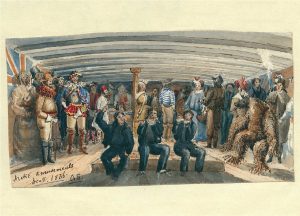Thomas Fisher Rare Books a treasure trove unto itself

PHOTO COURTESY U OF T THOMAS FISHER RARE BOOK LIBRARY: “Arctic Amusements” by Owen Stanley depicts the ship’s crew passing the time while stuck in sea ice in 1836-7.
By Annemarie Brissenden
You may know that a maritime mystery was solved this September when Arctic researchers found the HMS Terror, one half of the Franklin Expedition that had set out to seek the Northwest Passage in 1845. Her sister ship, the HMS Erebus, had been found by the same team last year.
What you may not know is that it has an Annex connection.
“Canada’s Arctic is one of the few places in the world that is still so unknown”—Adrian Schimnowski, CEO, Arctic Research Foundation
A naval officer and surveyor named Captain Owen Stanley had served on the Terror when it sailed to the Arctic in 1837-38. Stanley kept a daily diary and made sketches depicting the activities of the ship, later using them to create original watercolour paintings. That diary, those sketches, and the resulting watercolours are to be found in the University of Toronto’s Thomas Fisher Rare Books Library.
And this year, the sketches and watercolours are the basis of the library’s holiday card collection, a popular annual tradition.
“We first used the Owen Stanley image of the HMS Terror for the Chief Librarian’s card in 2014,” explained Maureen Morin, a graphic designer with the university’s libraries, in an email. “We had already selected it when the prime minister announced in September of that same year that the wreck of one of Franklin’s lost ships had been found, although we wouldn’t learn until later that it was the Erebus. When the wreck of the Terror was located in 2016, we thought it fitting to use that image as well as ‘Arctic Amusements’ for the holiday cards we sell.”
The HMS Terror had a long history, and had travelled to the Arctic more than once before being lost, said Pearce Carefoote, one of Thomas Fisher’s librarians. It was originally fitted to be a bomber during the War of 1812, and was at Baltimore where it was perhaps responsible for some of the bombs that inspired Francis Scott Key to write the “Star Spangled Banner”.
“Because the bombers were stronger, they had a better chance of surviving in the Arctic ice,” he added, explaining how the ship came to be part of arctic expeditions.
The items have been in the library’s collection since they were purchased from a rare book dealer in London, England, in 1971.
Carefoote said he believes the Franklin has captured the Canadian imagination because “it’s part of the enigma of the north that Canadians understand”. He also thinks that while we may never fully know what went wrong with the expedition, we do “know what they were up against”.
“Canada’s Arctic is one of the few places in the world that is still so unknown,” agreed Adrian Schimnowski, chief executive officer of the Arctic Research Foundation, the team that found both the Terror and the Erebus. The Franklin Expedition is “about human experience and condition; what’s interesting in the Arctic is that we’re always going to be facing the same element: environment. It’s so extreme.”
Loryl MacDonald, Thomas Fisher’s director, believes this year’s cards will be particularly popular. And not just because they are timely or speak to something uniquely Canadian, but because they are incredibly beautiful. Proceeds from the sale go towards the library’s development fund, which supports various projects with the university’s library system, including acquisitions.
She said that the rare books library is one of the top research libraries in Canada and North America.
“It’s a jewel in the crown, and it’s a gem,” said MacDonald. With a broad index of varied things ranging from Shakespeare’s folio to Leonard Cohen manuscripts, it is open to the entire community for free.
“People come from as far away as Japan, and as close as Huron-Sussex wanting to research the neighbourhood. It’s pretty amazing that you have these collections right in our neighbourhood.”
For further information on the University of Toronto’s Thomas Fisher Rare Book Library, or to order greeting cards, please visit the library’s website.
YOU MAY ALSO BE INTERESTED IN:
HISTORY (SEPTEMBER 2015): A haven for children’s literature by Annemarie Brissenden
